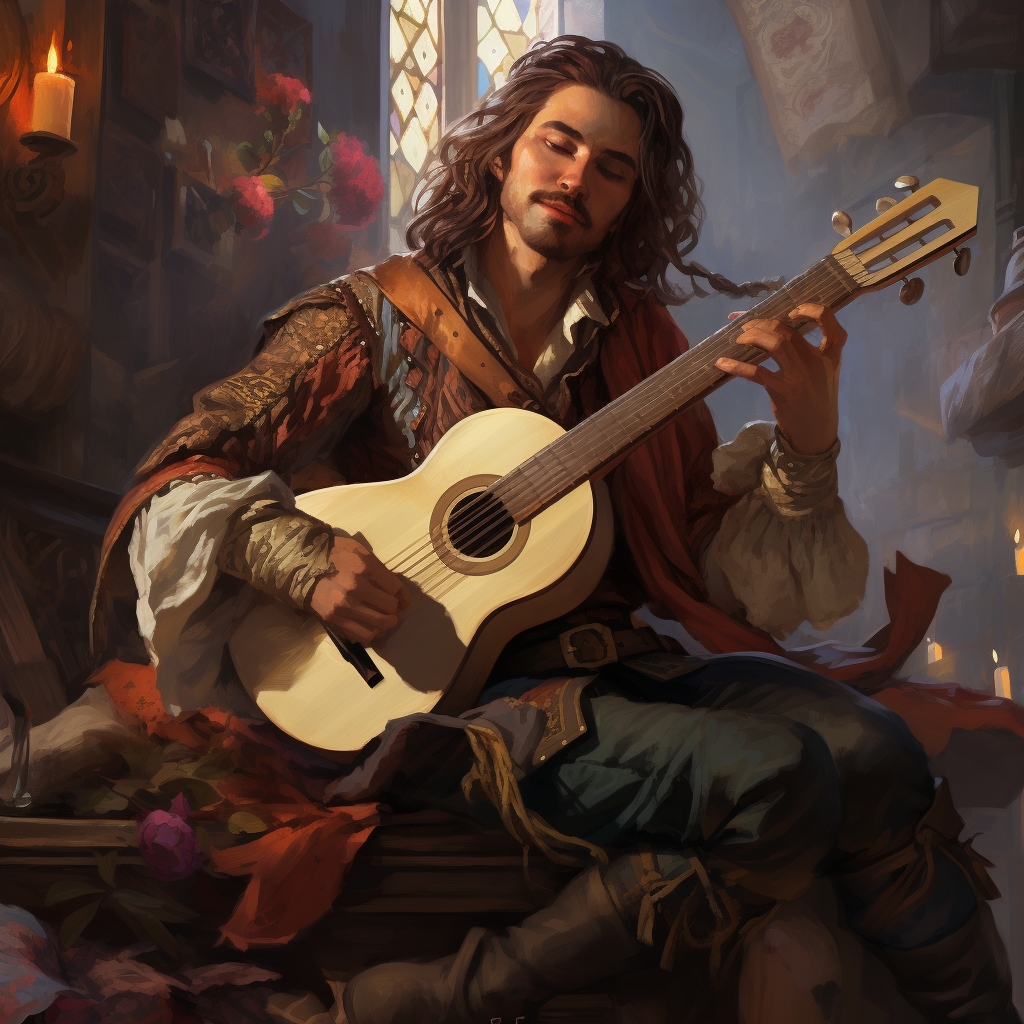Bards in D&D: An Overview
In the rich tapestry of classes within the world of Dungeons & Dragons (D&D), the Bard stands out as a captivating figure. Noted for their musical and magical abilities, Bards are the charismatic charmers of D&D, combining spellcasting, combat, and a broad range of skills with an undeniable charm and wit.
Bards are known for their versatility. The jack-of-all-trades within a D&D party, Bards are as comfortable in combat as they are providing support through healing, enhancing allies’ abilities, or using their charisma to deceive or charm enemies.
Bardic Origins in D&D
Bards first appeared in the original D&D as a class unlocked only after achieving levels in both the fighter and thief classes, making them something of a late-game addition. This complex multi-classing requirement was later simplified. In the Advanced Dungeons & Dragons 2nd edition, Bards emerged as a standalone class, showcasing their unique combination of musical abilities and spellcasting.
Unveil your passion for the captivating world of Dungeons & Dragons with our curated collection of Bards merchandise. Embrace the spirit of the game’s charismatic storytellers, let your style reflect their enchanting tales, and let your D&D enthusiasm reverberate with each piece you own. Your unique D&D style journey begins by clicking here, today!
Bards in Modern D&D
In the current 5th edition of D&D, Bards have become more versatile, equipped with a range of skills and abilities that offer broad utility and adaptability. Their primary ability is Charisma, vital to their spellcasting and performance skills.
Bards can choose from a broad spell list, including spells that heal, deceive, charm, and even deal damage. Their Bardic Inspiration ability allows them to provide bonuses to their comrades’ rolls, a potentially game-changing support tool. Additionally, their Jack of All Trades feature provides them with a bonus to any ability check they make that doesn’t already include their proficiency bonus, emphasizing their flexibility and adaptability.
Bardic Colleges
At the third level, Bards in D&D 5th edition choose a Bardic College, signifying a specific style of bardic performance or form of training. This choice significantly influences the Bard’s gameplay style and character development.
For example, the College of Lore focuses on knowledge and versatility, offering Bards extra skills and the ability to learn spells from other classes. Conversely, the College of Valor enhances the Bard’s combat abilities, providing additional attack options and the ability to use music to inspire resilience in their allies.
Role-playing a Bard

Role-playing a Bard offers numerous opportunities for creativity and character development. Bards often act as the face of the party, leading social interactions with their high Charisma. Their background as entertainers, musicians, or storytellers can provide depth to the character and interesting hooks for personal quests and motivations.
Playing a Bard: Tips and Strategies
While playing a Bard can be rewarding, their multifaceted role within a party can be challenging for newcomers. Here are some tips:
- Leverage Your Versatility: Bards excel when adapting to situations. Embrace this flexibility and make choices that play to this strength.
- Use Bardic Inspiration Wisely: Bardic Inspiration is a powerful tool. Use it strategically to bolster rolls where your party lacks proficiency.
- Choose Your Spells with Care: Bards can learn spells from other classes. This allows you to customize your spell list to suit your party and campaign needs.
Diverse Bard Subclasses
Beyond the College of Lore and Valor, other Bardic Colleges offer unique playstyles and thematic elements. For example, the College of Glamour (from Xanathar’s Guide to Everything) is ideal for those wishing to play a Bard with a captivating presence. On the other hand, the College of Swords, also from Xanathar’s Guide, creates a Bard that is a master of martial combat and acrobatic performance, ideal for those wanting to perform and duel with equal skill.
Experience the charm of the Dungeons & Dragons universe in a whole new way with our specially designed Bards merchandise. Let these pieces resonate with the enchanting tales spun by the game’s charismatic minstrels, and wear your passion for D&D on your sleeve. Click here and step into the shoes of a bard, and let your style narrate your own epic saga!
Bards in D&D Literature and Campaigns
Bards have played crucial roles in D&D literature and popular campaigns, embodying the spirit of adventure, wit, and creativity that is integral to D&D. Iconic characters such as the halfling Yubi from R.A. Salvatore’s The Cleric Quintet and Scanlan Shorthalt from the web series Critical Role have shown the potential of Bards in D&D.
The Impact of Bards on D&D Culture
Bards have significantly influenced D&D culture, often symbolizing the game’s inherent charm and storytelling essence. They embody the spirit of D&D – a world of adventure, fantasy, and the power of creativity.
Conclusion
Bards in Dungeons & Dragons offer a unique blend of magical and musical gameplay, a charismatic presence, and a versatile skill set, providing an exciting role-playing experience. They are the heart of the party, bolstering their allies with their music, charming their enemies, and navigating social scenarios with their wit and charm.
From their unique mechanics and rich lore to their strategies for playing and their impact on D&D culture, Bards paint a comprehensive picture in D&D. They remind us of the magic of storytelling and the joy of D&D. So here’s to the Bards, the heart of our parties and the soul of our adventures!